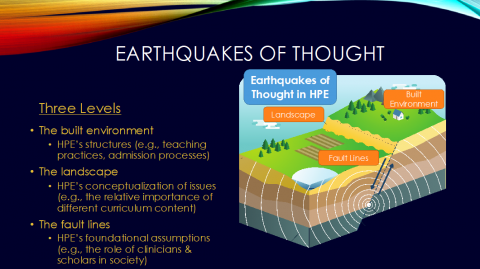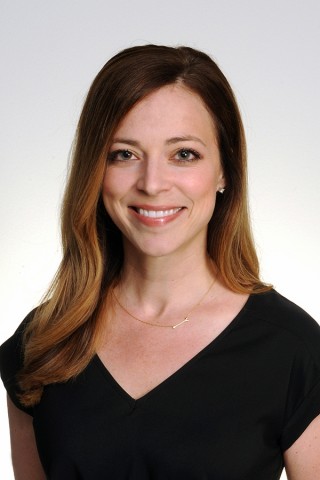Dr. Lara Varpio challenged educators and thought leaders in health professions education (HPE) to rethink the impossible during her Generalists in Medical Education plenary talk entitled “When the Earth Moved Under Our Feet.” In reflecting on changes in health professions education during the COVID-19 pandemic, Dr. Varpio suggested that there were “earthquakes” in our thinking—seismic events that shook the very foundations of our core as educators and thought leaders. She helped the audience reflect on changes to our normal every day practices that we once knew to be true. Speaking of change…
Dr. Varpio described three different levels within HPE where we have experienced these shockwaves of thought: the built environment, the landscape, and the fault lines (Figure 1).
The Built Environment: These are the tangible, everyday practices most readily visible because of an earthquake of thought. In HPE, it is the things we notice, from the admissions processes, the learning environment changes, to our classroom teaching practices. As our educational contexts slowly begin to return to pre-COVID ‘normal’, it is a moment to celebrate—but not a time to revert or slow our process and progress. In the spirit of rethinking possibilities, what changes in your place of practice made an impact for good? Consider changes which may have broadened the learner experience and extended beyond your imagination.
The Landscape: These are the spaces that uphold the built environment. These are the ways we think about phenomena we teach in the built environment. In HPE, it is all of the things that go into helping us generate future generations of clinicians such as curriculum mapping design, the content we teach, or the competencies we measure. At this critical moment, the greatest change challenge to the HPE landscape is with complacency—the comfortable notion that everything is fine as it is. What efforts are in place at your place of practice to reshape your landscape? Consider what underlying principles made an impact at your place of practice and how you brought it to life.
The Fault Lines: These are the foundational assumptions that underpin HPE as a field and our deeply rooted institutional values. In HPE, it is who we are, what we do—from the role we play in society as clinicians, educators, and scientists to the ways in which we promote health literacy to the population within our built environment and landscape. The past year has reminded us that life can change at any moment; the tectonic plates beneath our institutions can shift, and so we must be nimble in our ways of thinking to make knowledge about health literacy accessible to the public population. What foundational assumptions changed in your place of practice? Consider how you can model for the students the importance of talking to the public through engagement on a personal level.

Figure: Three Levels in Earthquakes of Thought by Dr. Lara Varpio
As change evolves, our calling as educators and thought leaders in HPE is to reflect and be critical of the things that made the impossible to possible. It is a time to ask ourselves why we were doing what we did before COVID-19 and whether we should continue to move forward in that manner. And, can we do better?
Special thanks to Dr. Lara Varpio from Uniformed Services University of the Health Sciences for her contributions to this post.
#MedEdPearls are developed monthly by the Central Group on Educational Affairs. Previously, #MedEdPearls explored topics including universal design for learning, what happens after medical errors are disclosed, and a one minute pause on mattering.

Anna Lama, EdD, MA, is a medical and health professions educator and currently serves as Assistant Professor in Medical Education and Director of Assessment for Undergraduate and Graduate Medical Education at West Virginia University School of Medicine. Anna’s areas of professional interest include medical students as teachers training, professional development of clinical and research educators, and curricular design. Anna can be followed on Twitter or contacted via email.
#MedEdPearls

Jean Bailey, PhD – Virginia Commonwealth University School of Medicine
Rachel Moquin, EdD, MA – Washington University School of Medicine

